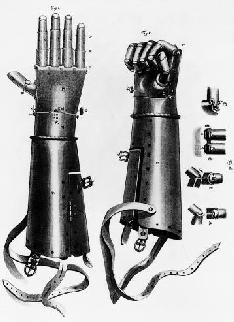Scientists in Chicago are developing a superior control system for prosthetic arms to help users to make far more accurate movements - just by thinking.
 Toff Kuiken at the Rehabilitation Institute of Chicago is pioneering an approach known as targeted muscle re-innervation (TMR). Patients are prepared for the device by first detaching nerves that supply the muscles of the chest wall that would once have helped to support and move their missing arm. Then, the motor nerves from the arm stump that would have supplied the limb are re-routed into the denervated chest wall muscles. After 6 months when the patients think about moving their missing hand or fingers the muscles of the chest respond. This can be picked up by an array of skin sensors and used to electronically control the movements of the prosthesis. Volunteers who have been equipped with the system have found that they can perform movements much more easily and intuitively than with conventional devices, which are activated using other muscles in the back. Now, to improve the system yet further, the researchers have developed computer software that studies the precise patterns of activity in the chest muscles and can take into account the timing and frequency of muscle movements. Using this approach they can discriminate, with 95% accuracy, between the electrical signatures of 16 different movements of the hand, arm and fingers.
Toff Kuiken at the Rehabilitation Institute of Chicago is pioneering an approach known as targeted muscle re-innervation (TMR). Patients are prepared for the device by first detaching nerves that supply the muscles of the chest wall that would once have helped to support and move their missing arm. Then, the motor nerves from the arm stump that would have supplied the limb are re-routed into the denervated chest wall muscles. After 6 months when the patients think about moving their missing hand or fingers the muscles of the chest respond. This can be picked up by an array of skin sensors and used to electronically control the movements of the prosthesis. Volunteers who have been equipped with the system have found that they can perform movements much more easily and intuitively than with conventional devices, which are activated using other muscles in the back. Now, to improve the system yet further, the researchers have developed computer software that studies the precise patterns of activity in the chest muscles and can take into account the timing and frequency of muscle movements. Using this approach they can discriminate, with 95% accuracy, between the electrical signatures of 16 different movements of the hand, arm and fingers.
The next step will be to speed up the decoding process and link it to the prosthesis, so that users can use thought power to move their arm in real-time, something that the team predict they will be able to do within the next two years.
- Previous Opals are thanks to Uranium
- Next Twins not so identical after all










Comments
Add a comment